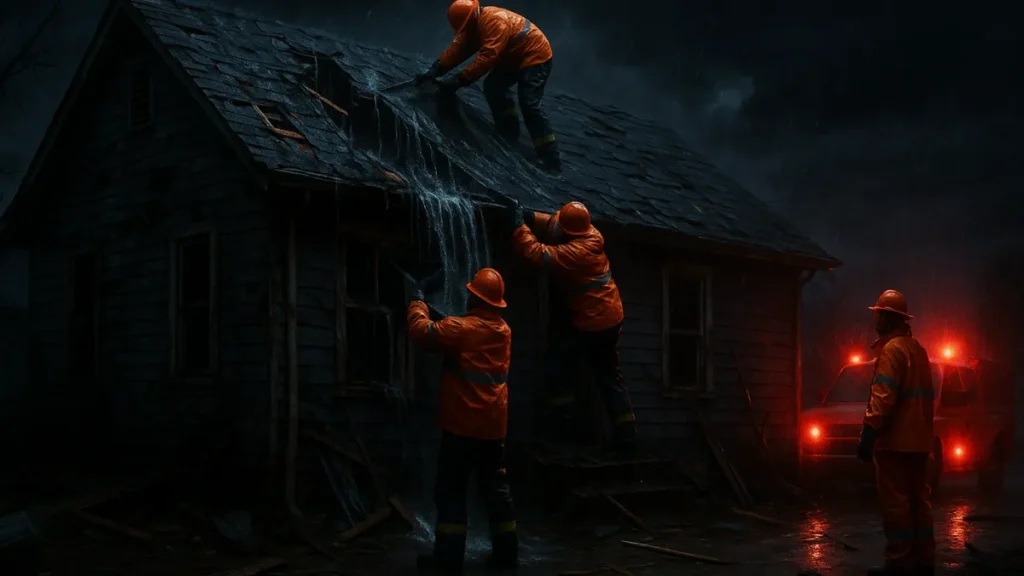Your roof is a sophisticated system that is quite important for safeguarding your house, not only shingles, nails, and plywood. Roof ventilation is among the most often disregarded yet crucial components of this system. Although often invisible to the eye, good ventilation helps regulate temperature, stop moisture accumulation, and prolong the life of your roofing materials.
In Oregon, where dwellings face changing temperatures, wet seasons, and sporadic snow, ventilation is not only essential but also really beneficial. We will explore in great detail in this book the reasons roof ventilation is so important, how it works, and what results from neglect of it.
1. Understanding Roof Ventilation: What It Is and How It Works
Roof ventilation balances the intake of cold air with the evacuation of warm, damp air by allowing circulation in your attic area. usually consists of two parts:
- Usually under the eaves or soffits, intake vents draw in cooler outside air.
- Found close to the gables or roof ridge, exhaust vents let moisture and hot air flee.
Without mechanical intervention, the natural rising of warm air—known as the stack effect—along with wind pressure produces a passive airflow system that aids in control of attic temperature and moisture levels.
In Oregon, where the climate may be both chilly and humid, this equilibrium is particularly crucial. Without ventilation, warm air from your house rises and condenses in the chilly attic in winter, causing moisture build-up, mold, and sometimes ice dams.
A poorly ventilated attic can retain hot air in summer, driving temperatures beyond 140°F. Your HVAC system works harder, your energy costs go higher, and shingles are prematurely aged as this heat radiates down.
Basically, roof ventilation is the temperature and moisture control for your house, so it is among the most important but unseen components of your roofing construction.
2. The Dangers of Poor Roof Ventilation
Many homeowners are unaware their attic is inadequately vented until they have expensive symptoms; by then, damage is usually done. Bad ventilation can cause numerous major issues:
Moisture Buildup: In cooler Oregon months, heated indoor air rises and condenses in the attic if it has nowhere to escape. Water-damaged insulation, decaying rafters, and mildew or mold development follow from this.
Ice Dams: Heat imprisoned in the attic melts snow on the roof in ice dams. At the eaves, that water refreezes and forms deadly ice dams. Extreme leaks and structural damage to gutters and roofs can result from these ice formations.
Increased Energy Bills: Hot air in the attic accumulates and radiates down in warmer seasons. Your air conditioner has to work more to chill your house, which will result in noticeably more energy use.
Shingle Damage: Roofing materials age more quickly in too much attic heat. Shortening their lifetime and voiding manufacturer warranties, asphalt in shingles can dry out, curl, and fracture.
Structural Decay: Poor ventilation causes stored moisture that over time weakens the roof deck, rots frames, and compromises the structural integrity of the house.
While many of these issues are easy to avoid, their fixes are costly. Just making sure your roof has balanced intake and exhaust ventilation will help to reduce most of these hazards, therefore safeguarding your family’s comfort and investment.
3. Key Benefits of Proper Roof Ventilation in Oregon Homes
The temperature of Oregon provides ideal circumstances for problems with roofs linked to inadequate ventilation. The following immediately benefits you as a homeowner from a well-ventilated roof:
Prevents Mold and Mildew: Mold and mildew grow best in dark, moist environments. In the wet seasons especially, a ventilated attic guarantees that moisture does not build up.
Extends Roof Lifespan: Reducing heat and moisture accumulation helps your shingles, underlayment, and roof deck stay in better condition longer, therefore perhaps extending the life of your roof by 5–10 years.
Energy Efficiency: Good ventilation keeps attic temperatures constant. This increases the efficiency of your heating and cooling systems, therefore lowering year-round energy usage.
Protects Insulation: Ventilation helps to keep insulation dry and functioning, therefore preserving a constant interior temperature.
Reduces Indoor Temperature Extremes: Hot air vented outdoors keeps upstairs rooms drier in the winter and cooler in the summer, therefore improving the comfort of the living environment.
In a place like Oregon, where both energy economy and moisture management are critical, appropriate roof ventilation is not optional; rather, it is basic for house health and affordable living.
4. Signs Your Roof May Have Poor Ventilation
Early recognition of inadequate ventilation symptoms will help you prevent significant repairs later on. Some symptoms include
A Hot or Stuffy Attic: In July, your attic ought to be just a few degrees warmer than the outside. One obvious warning indication is too much heat.
Ice Dams in Winter: Trapped attic heat is probably the cause if you find big icicles or ice building at the eaves.
Musty Odors: Usually indicating mold or mildew from condensation, a damp or musty smell in the attic or higher levels indicates this as well.
Rust or Corrosion: High moisture content explains why you find rust on metal components in your attic—such as pipes, vents, or nails.
Warped or Sagging Roof Deck: This is an advanced indicator usually indicating that structural components of your roof have been weakened by extended dampness.
If you believe any of these problems exist, call a qualified roofing contractor such as Roseburg Roofing Inc. to evaluate your ventilation system and offer advice specifically for Oregon’s environment.
5. Choosing the Right Ventilation System for Your Roof
There are several kinds of ventilation systems; the optimal one will rely on the architecture of your house, roof pitch, and environment. Usually, Oregon houses gain from a mix of exhaust and intake vents. These are many of the best choices:
Ridge Vents: Installable at the top of the roof, ridge vents offer continuous exhaust. Soffit vents combined with them produce a rather efficient passive ventilation system.
Soffit Vents: Found under the eaves, soffit vents let fresh air into the attic area.
Gable Vents: Mounted on the gable ends of a house, gable vents offer both intake and exhaust but are less efficient in an attic without appropriate airflow.
Roof Louvers: Installed close to the crest, roof louvers—box vents or static vents—offer modest ventilation but require many units to be efficient.
Powered Attic Fans: Perfect for homes lacking natural ventilation, powered attic fans assist in expelling heated air. They should be utilized cautiously, though, to prevent drawing conditioned air from the living area.
To find out whether your house satisfies the minimum advised ventilation ratio of 1:300—one square foot of ventilation for three hundred square feet of attic space—a roofing expert can do a ventilation audit. This guarantees balanced and effective operation of your system.
FAQs
Q1: How do I know if my attic is properly ventilated?
Check for signs like extreme heat, condensation, or musty smells. A roofing expert can also perform a professional ventilation assessment.
Q2: Can roof ventilation lower my energy bills?
Yes. A properly ventilated attic reduces heat buildup in summer and moisture in winter, both of which impact your HVAC system and energy use.
Q3: Is it possible to have too much roof ventilation?
Yes. Over-ventilating, especially with unbalanced intake and exhaust, can disrupt airflow and even draw in moisture. Always aim for balanced ventilation.
Q4: Should I install roof vents myself?
It’s best to leave this to professionals. Incorrect installation can lead to leaks, poor performance, or even damage to the roofing system.
Conclusion
Though you might not give roof ventilation much thought, its effects on the lifetime, energy economy, and general comfort of your house are rather significant—especially in an Oregon-like environment. From stopping mold and wood rot to lowering your energy costs and increasing the lifetime of your roof, ventilation is a quiet guardian of your most valuable purchase.
It may be time to check the ventilation on your roof if your attic feels like a sauna in summer or if your heating expenses are astronomical in winter. Never wait until issues start to show up. For a professional assessment and customized ventilation ideas fit for Oregon houses, get in touch with Roseburg Roofing Inc.


